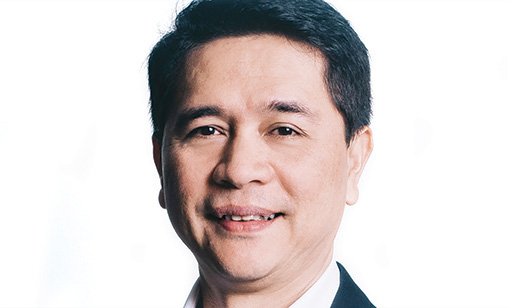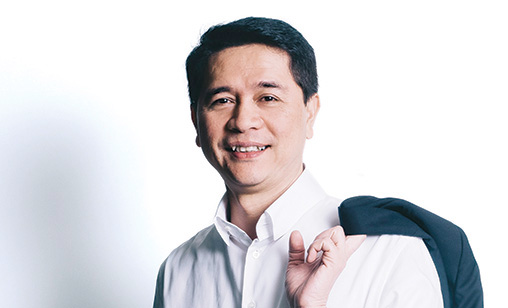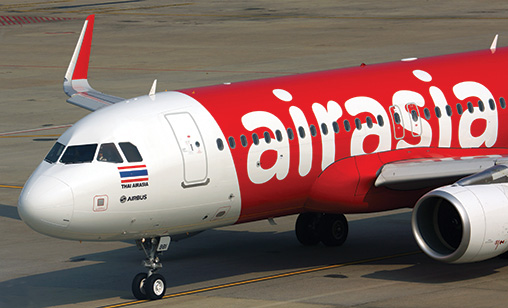Cover Story
Thailand's smartest airline
Thai AirAsia is the only Thai airline to be in profit this year. To maintain its winning streak, it is building a hub south of Bangkok to guarantee its expansion.
October 1st 2017
Thai AirAsia’s Tassapon Biljeveld is a man with a mission. The 50-year-old founding CEO of the only profitable carrier in Thailand this year told Orient Aviation he will stay around until he “kills some of the enemy airlines”. Read More »
And he has his targets. “At the moment, the market is saturated. There’s way more supply than demand. There’s too many aircraft flying in the ASEAN airspace, especially in Thailand,” he said.
 |
“The authorities have to be more proactive in governing the airlines that don’t have strong financial performance. If they go bankrupt at any time, it will affect the economy and also the passengers. There are rules and regulations on governance, but none of them are actively pursued.
“We actually have a problem with our CAAT (Civil Aviation Authority of Thailand). It has to be more proactive. For example, if you have a negative balance sheet, a huge number, but you want to bring in more aircraft, I think the CAAT has to raise some questions. Its people should ask these airlines how they think they can market their seats and new destinations if their balance sheet is so weak.”
Tassapon conceded, however, that there is very little he can do to bring about change. “I can only voice my concerns to the authorities, which I have done. I have to make myself strong by looking at my costs, making sure my costs are low and my balance sheet is strong. Our balance sheet continues to be very strong. Our costs are the lowest in the country so that makes us stand out from our competitors,” he said.
Aviation in Thailand had a turbulent 2016 and it is experiencing challenges this year. Profits and yields continue to dwindle at the kingdom’s carriers and they are being forced to slow expansion. Nevertheless, Tassapon has a trick or two up his sleeve to beat the market and have Thai AirAsia come out on top.
“Life goes on. We are adding four to five aircraft a year, opening new destinations, hiring more staff,” he told Orient Aviation in Bangkok. “It’s moderate growth every year, but it’s still growth.”
For the first half of 2017, Thai AirAsia had revenues of 17,486 million baht (US$529 million), an improvement of 5% compared with the same months in 2016. The carrier’s net profit was down 48%, however, to 741 million baht (US$22.4 million). Tassapon said the lower earnings were the result of higher fuel costs and a jet fuel excise tax on domestic flights that CAAT introduced in January.
| ICAO downgrade did not hurt Thai AirAsia Thai AirAsia CEO, Tassapon Biljeveld, told Orient Aviation the airline’s growth has not been effected by the International Civil Aviation Organization (ICAO) downgrade of Thailand’s air safety rating to Category 2 in 2015. “For Thai AirAsia, on our A320 fleet, we have no issue with the ICAO downgrade at all because China does not acknowledge the ICAO ruling. We have added many destinations and increased frequencies to China in the last two years,” he said. “In India, we have opened three cities this year and they don’t really care about ICAO either. All the ASEAN (Association of Southeast Asian Nations), they don’t care.” The situation is very different at Thai AirAsia’s long-haul sibling, Thai AirAsia X (TAAX). “Our expansion had no correlation with the ICAO downgrade, but at TAAX we could not expand for the past three years now. “We can only add frequencies to destinations where we fly. This year we are adding one flight to Incheon and one more flight to Narita, but there are no new destinations. Once it’s lifted, TAAX will add more destinations in China and Japan.” The general consensus is that ICAO will soon restore Thailand’s ‘Category 1’ rating after significant changes and improvements at the CAAT and Thai carriers have been implemented. As part of that process, the CAAT revoked the air operator certificates (AOCs) of 13 Thai-registered airlines in early September, including those at Thai VietJet Air and Orient Thai Airlines, which meant they could only fly domestic services. Tassapon said this had no impact on Thai AirAsia. “No, there’s no impact. Not at all. Not at all. Of those 13, half of them are not in operation. They hold the AOC, but don’t use it. The other half are mostly charter airlines. There’s no effect for us because we don’t have any transfer traffic from them,” he said. |
In this year’s first quarter, to March 30, Thai AirAsia’s average fares increased 11% year-on-year.Despite its growth earlier in the year, the airline’s yields declined by 5% in the second quarter as more carriers reinstated frequencies and launched routes in competition with Tassapon’s carrier.
Thai AirAsia’s main hub is Bangkok’s timeworn Don Mueang Airport, Asia’s oldest airport and Thailand’s gateway to the world until the opening of Suvarnabhumi Airport in 2006.
Don Mueang is congested and its facilities need a facelift. In 2015, Don Mueang became the world’s largest low-cost airport, handling 30.3 million passengers that year and exceeding its design capacity of 30 million.
Don Mueang is a flagship for Thailand’s booming free market economy. At no other airport will passengers find as much competition for their business as they do there. It also is the hub for Nok Air, NokScoot, Thai Lion Air and New Gen Airways.
As a result, Thai AirAsia is under constant pressure to expand, differentiate and undercut the competition. But there are limitations at Don Mueng that even the savviest sales and marketing executives can’t overcome: insufficient ramp space and slots.
 |
“We are focusing on developing Pattaya U-Tapao Airport as our next main hub. Don Mueang is full. We have to explore new opportunities. We are working very closely with the government in developing U-Tapao Airport,” he said.
“U-Tapao will be just like Don Mueang. Traffic will be ASEAN, Asia, China and India. AirAsia X, our long-haul unit, will be there as well.
“We can only add a few more aircraft to our operations in Don Mueang. It will be tough and it will be a long time before development takes place, e.g. new terminals and other infrastructure.
“The plans come and go, but as far as I know they [AOT] are not planning to build any terminals at the moment. Even if they started building today, the time frame to construct a terminal or extend the existing ones would be another five years at least. I would rather put some of my eggs in U-Tapao.”
Thai AirAsia will not be alone at U-Tapao. Aggressive rivals like Thai Lion Air and New Gen Airways have set up bases at the airfield, with most of their flights targeting Mainland tourists. NewGen plans to make U-Tapao its new base because of slot constraints at the two Bangkok airports. The airline’s business is focused on charter flights between Thailand and China. It operates an average of 30 flights a week to 25 Mainland cities with its B737 fleet.
Hong Kong Airlines and LCC HK Express are considering flights from Hong Kong to U-Tapao. Hainan Airlines flies from U-Tapao to Sanya three times a week.
AirAsia has been rapidly building its network from U-Tapao since it launched flights from the airport in 2015. AirAsia flies to Kuala Lumpur and Tassapon’s Thai AirAsia serves Chiang Mai, Hat Yai, Macau, Nanchang, Nanning, Phuket, Udon Thani and Ubon Ratchathani from U-Tapao.
The expanding airport is a 30 minute drive south of Pattaya, a coastal destination favoured by Mainland tourists. It will open a passenger terminal by year end and has the goal of increasing passenger arrivals from 800,000 a year to three million in 2020. In the second phase of its development, the Thai Navy-operated facility airport will boost capacity to 15 million passengers annually by 2022.
“The government is pushing very hard and providing quite good incentives to develop U-Tapao. A high-speed train will be going there and a lot of infrastructure is being put in place. We think we can rely on U-Tapao as our new future hub,” Tassapon said.
Quizzed on whether the government was handing out subsidies for flights to U-Tapao, Tassapon said he would not call it that. “Rather, I would say that because the whole big piece of land there, all the hundreds of acres, was declared a special incentive zone for investment, we got the board of investment involved. We got some tax rebates, all sorts of things,” he said.
| A321neo to solve capacity growth? Thai AirAsia needs larger aircraft. The LCC has consistently high load factors. In 2015, its load factor averaged 81%. A year later, it had reached 84%. To date, in 2017, the carrier filled an average 88% of its available seats. Another reason for the acquisition of higher-capacity aircraft is the growing congestion and slot shortage at many of the region’s airports. “We are working on acquiring the A321neo. We have not decided yet, but we are looking into it with our operations team because a lot of airports are slot-congested. As we cannot increase the frequency of our flights, we have to use bigger planes,” Tassapon said. “We are still crunching the numbers. The operational team is determining if we can turn around an A321 in the exact same time as an A320. If it works, we must be confirming some A321s.” AirAsia has 100 orders for the A321neo and approximately 260 more orders for the A320neo. Its contracts with Airbus offer the flexibility of converting A320s to larger A321s, according to the airline’s latest operational requirements. “For example, we have three flights a day from Bangkok to Hong Kong. I would like to add two, three more, because there is demand there, but Don Mueang is congested and in Hong Kong, obviously you can’t get any more slots, so we need to look at bigger aircraft,” said Tassapon. “But if it’s too big, like an A330 in the same slot, we cannot fulfil our turnaround promise. So the A321neo is something we are looking into. It’s not that much bigger but at least you have 30-40 additional seats.” |
U-Tapao is not the only Thai seaside destination the group hopes to conquer. Across the Gulf of Siam, in Hua Hin, AirAsia has just closed a deal with the local airport. “We just finalized it. AirAsia from Malaysia will be starting from there in November or December with flights between Hua Hin and Kuala Lumpur,” he said.
“Thai AirAsia will probably commence flying from Hua Hin to either Singapore or Hong Kong. We are working on it. We have good support from the city and from the airport itself. Immigration facilities are in place.”
Thai AirAsia has a fleet of 54 A320 aircraft, including four A320neo. It added three neos in the first half of this year and will take delivery of another three by December 31. “We are adding six aircraft this year and six next year. In the following three to four years we will be adding five aircraft annually,” Tassapon said, and added all of its future deliveries will be the re-engined neo variant.
Now in its 14th year of operations, Thai AirAsia serves 52 destinations in 13 countries with 80 routes. This year it has added Don Mueang-Da Nang, Chiang Mai-Ubon Ratchathani, U-Tapao -Ubon Ratchathani and U-Tapao-Phuket. It has increased frequencies out of Bangkok to Khon Kaen to five flights a day; Roi Et to three flights a day; Penang to two flights a day; Phnom Penh to three flights a day; Chiang Mai to Surat Thani to two flights per day and from Hat Yai to Kuala Lumpur and U-Tapao to Udon Thani also to twice daily flights, respectively.
In recent months, India has become a focus for expansion. The airline believed the Thailand – India market has huge potential for investment and tourism. In September, it launched flights from Bangkok to Jaipur and Tiruchirapalli, complementing its existing network to Bengaluru, Chennai, Delhi, Kochi and Kolkata. It also offers daily flights to the Maldives.
 |
“The China market used to be very good, but since the zero baht tours crackdown it has not returned to where it was. Its a bit tough. We are not making a loss, but we are losing a lot of yield on our China routes. I hope next year it will go back to where it was, so China can become strong again,” Tassapon said.
Thailand and Thai AirAsia have shifted their focus to individual Chinese travellers. The kingdom and its first budget airline also had some luck come their way after Chinese and South Korean diplomatic relations deteriorated over the deployment of U.S. military weapons in South Korea. As part of the fallout, Beijing banned Chinese tour groups from visiting South Korea, which gave a fillip to the Thai tourism. To June 30, Mainland arrivals in Thailand were up 8% over the same period in 2016.
Tassapon is worried that the threat of a glut in the market and over ordering is real, but he has more immediate issues to manage, including his investors. Challenged about Thai AirAsia’s declining profitability in the first and second quarter of 2017, he was quick to point to the increased jet fuel price.
“I’ve been telling the investors that you cannot compare this year’s numbers to last year’s numbers. They will be down by at least 40%-50%. The fuel price last year was much less than this year. So, if you apply last year’s fuel price to this year’s operational environment, the number [profit/loss] would be exactly the same,” he said. The airline has 74% of its fuel requirements hedged at US$62 per barrel for the remainder of 2017.
Tassapon is confident he will achieve a good result for Thai AirAsia in 2017, but he admitted the net profit could small. “I can’t mention the numbers because the market will screw me, but my target passenger count is 19.5 million. I am 100% sure I will achieve that number. I will also achieve my revenue target, but in terms of profit, it might be a little bit down because of the yield erosion in the China market.”
Thai AirAsia is 55%-owned by Asia Aviation PLC and 45%-owned by the Malaysia-based AirAsia Group. In 2016, King Power, Thailand’s largest travel retail group, purchased a US$225 million stake in Thai AirAsia.
The acquisition of 39% of holding company Asia Aviation PLC makes King Power the second largest shareholder in Thai AirAsia. “Whenever we raise our hands they will come in and help us out, especially with regards to connections with the government and issues with the airport,” Tassapon remarked on the King Power shareholding.
It would appear that Tassapon and his Thai AirAsia have the right friends in the right places and he is not ready to call it quits any time soon. “When I kill some of those enemy airlines, then I will move on,” he laughed.